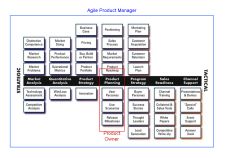Chris posted the following comment to Part 3 of this series.
Look forward to pt. 4, because so far pt. 3 has done little to bring clarity to the issue. For example, in pt. 1 your Scrum definition calls the Product Owner the “voice of the customer,” but that’s exactly what the Cranky PM says the Product Manager should be. So which is it? To those of us trying to, hoping to, move to a more agile process, this type of contradictory advice is paralyzing.
One suggestion I saw that seemed to make sense is having an assoc. PM take on the product owner role. I like that, but it implies that the product owner comes from the product (business) team, not the engineering/tech team. Jennifer Fawcett, on the other hand, recommends the product owner come from engineering. Again, contradictory advice.
I know that each organization is different, and that there are no set rules, but after spending the last hour reading through your posts and replies, I’m more confused than I was before, and still not convinced that the product manager/owner aren’t one in the same.
Point taken. That’s what happens when you write a multi-part series with large lapses of time between each part. You forget that what you wrote in previous parts may not be as clear as you thought when you wrote them.
So before getting to part 4 (it’s coming soon, I promise), I want to address the comment above and make sure others are not seeing a similarly confusing message as they read the various parts one after another.
One point of confusion in the article above is the definition used for Product Owner in part 1.
The definition I gave:
The Product Owner represents the voice of the customer. They ensure that the Scrum Team works with the right things from a business perspective. The Product Owner writes User Stories, prioritizes them, then places them in the Product Backlog.
is not my definition but the standard Scrum definition, and goes to the heart of the confusion of whether a Product Manager can/should also be the Product Owner. In this case, the definition came from the Scrum(development) page on Wikipedia. The same Wikipedia page has (at least at the time I’m writing this) another definition of Product Owner that reads:
- Product Owner: The person responsible for maintaining the Product Backlog by representing the interests of the stakeholders
This is a little more generic definition than the first, as it does not explicitly reference “customer”.
If I could make changes, I’d do two things:
- Change the name from Product Owner to Iteration Manager, Requirements Manager, Requirements Analyst (or something similar)
- Define the role as: “The person responsible for ensuring that iterations focus on delivering on the priorities and objectives as defined by the customer or customer advocate. The Product Owner is responsible for Scrum related artifacts such as User Stories, Epics and prioritizing the Product Backlog during each release cycle.“
This does two things. By changing the name of the role, it removes any ambiguity about the scope of the role and the focus of the person in it. It also clarifies the relationship between this role and that of the “voice of the customer”, or as I call it the “customer advocate”. (i.e. the customer, the Product Manager or other similar entity).
The folks at Enthiosys have recently posted an article on this topic and use the following diagram to indicate the activities the “Product Owner” is responsible for.
(click to enlarge)
As you can see from the diagram, the scope is VERY narrow and the focus is on inbound development planning activities. In their article, they also state:
The Product Owner addresses Agile development teams’ intense need for real-time input on user stories, user interface design, and requirements when Agile Product Managers are inevitably away from their desks.
Enthiosys, like other people I referenced in part 3, state that the two roles should be filled by different individuals. The Product Manager is the voice of the customer (I agree with Cranky here), and in a prelude to part 4, I’ll say that I agree with Jennifer Fawcett that the Product Owner should be from Engineering.
Hope that helps clarify any confusion my previous posts may have caused.
Coming soon — part 4 — where the “Product Owner” should sit, and whether there is such as thing as an “Agile Product Manager”.
Saeed
Agile/Scrum and Product Management (part 3)
